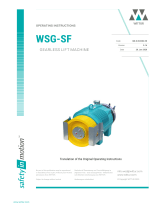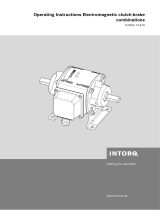Mayr ROBA-brake-checker plus DC Installation And Operational Instructions
- Type
- Installation And Operational Instructions
This manual is also suitable for
Mayr ROBA-brake-checker plus DC is a monitoring module for DC consumers that provides armature disk motion recognition, release and drop-out recognition, preventative function monitoring, wear recognition, error recognition, and functional reserve. It is designed for use with an input voltage of 24 or 48 VDC and has a maximum output current of 10 A / 5 A. The device can be adjusted for the respective brake before initial operation, and it features a DIP switch for simple adjustment of holding voltage and overexcitation time.
Mayr ROBA-brake-checker plus DC is a monitoring module for DC consumers that provides armature disk motion recognition, release and drop-out recognition, preventative function monitoring, wear recognition, error recognition, and functional reserve. It is designed for use with an input voltage of 24 or 48 VDC and has a maximum output current of 10 A / 5 A. The device can be adjusted for the respective brake before initial operation, and it features a DIP switch for simple adjustment of holding voltage and overexcitation time.












-
 1
1
-
 2
2
-
 3
3
-
 4
4
-
 5
5
-
 6
6
-
 7
7
-
 8
8
-
 9
9
-
 10
10
-
 11
11
-
 12
12
Mayr ROBA-brake-checker plus DC Installation And Operational Instructions
- Type
- Installation And Operational Instructions
- This manual is also suitable for
Mayr ROBA-brake-checker plus DC is a monitoring module for DC consumers that provides armature disk motion recognition, release and drop-out recognition, preventative function monitoring, wear recognition, error recognition, and functional reserve. It is designed for use with an input voltage of 24 or 48 VDC and has a maximum output current of 10 A / 5 A. The device can be adjusted for the respective brake before initial operation, and it features a DIP switch for simple adjustment of holding voltage and overexcitation time.
Ask a question and I''ll find the answer in the document
Finding information in a document is now easier with AI
Related papers
Other documents
-
 Wittur WSG-SF.2 Operating Instructions Manual
Wittur WSG-SF.2 Operating Instructions Manual
-
Omron JZAB0P2B User manual
-
YASKAWA PROFINET V1000 Technical Manual
-
Siemens Siprotec 7UM611 User manual
-
YASKAWA A1000 series Technical Manual
-
Marathon AVC63-12/125-10 Owner's manual
-
Marathon APR125-5 Owner's manual
-
Marathon PM100/200 Owner's manual
-
Marathon AVC63-4A Owner's manual
-
 INTORQ 14.800 Series Operating Instructions Manual
INTORQ 14.800 Series Operating Instructions Manual
















